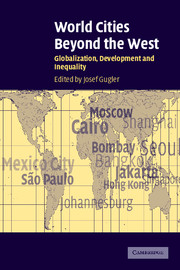Book contents
- Frontmatter
- Contents
- List of figures
- List of maps
- List of tables
- List of contributors
- Acknowledgments
- World cities beyond the West
- Introduction
- Part 1 The impact of the global political economy
- 1 Shanghai: remaking China's future global city
- 2 Seoul: complementing economic success with Games
- 3 Bangkok: evolution and adaptation under stress
- 4 Cairo: too many people, not enough land, too few resources
- 5 Mexico City in an era of globalization and demographic downturn
- Part 2 The impact of the state
- Part 3 The impact of popular movements
- Afterword
- Index
- References
5 - Mexico City in an era of globalization and demographic downturn
Published online by Cambridge University Press: 12 October 2009
- Frontmatter
- Contents
- List of figures
- List of maps
- List of tables
- List of contributors
- Acknowledgments
- World cities beyond the West
- Introduction
- Part 1 The impact of the global political economy
- 1 Shanghai: remaking China's future global city
- 2 Seoul: complementing economic success with Games
- 3 Bangkok: evolution and adaptation under stress
- 4 Cairo: too many people, not enough land, too few resources
- 5 Mexico City in an era of globalization and demographic downturn
- Part 2 The impact of the state
- Part 3 The impact of popular movements
- Afterword
- Index
- References
Summary
Recent political and economic changes, both in Latin America and beyond, demand that we take a fresh view at the way in which we view mega-city development, particularly within an increasingly globalized environment. There are several intellectual imperatives to confront. First, the democratization process in Latin America has required that governments take a fresh look at the way in which cities are governed. Also, the growing disenchantment that some Latin American populations feel towards their national leaders has led to a resurgence of interest in local government, and has quickened pressures for a “new federalism” that shifts the locus of power, away from central government, towards greater state and city autonomy (Rodríguez 1997).
A second imperative to emerge is the significant shift towards decentralization and devolution. This can occur at the national level as regional and city governments have greater aegis with respect to central government. This process has found quickening support among international agencies such as the World Bank (Jones and Ward 1994b; Rodríguez 1997). In Mexico, for example, austerity measures introduced during the 1980s, along with economic restructuring and political reform, have intensified the need for the local authorities to do more with less. A greater willingness to embrace decentralization and administrative reorganization has been a direct outcome of this process (Morris and Lowder 1992; Rodríguez and Ward 1992, 1995).
- Type
- Chapter
- Information
- World Cities beyond the WestGlobalization, Development and Inequality, pp. 151 - 188Publisher: Cambridge University PressPrint publication year: 2004

